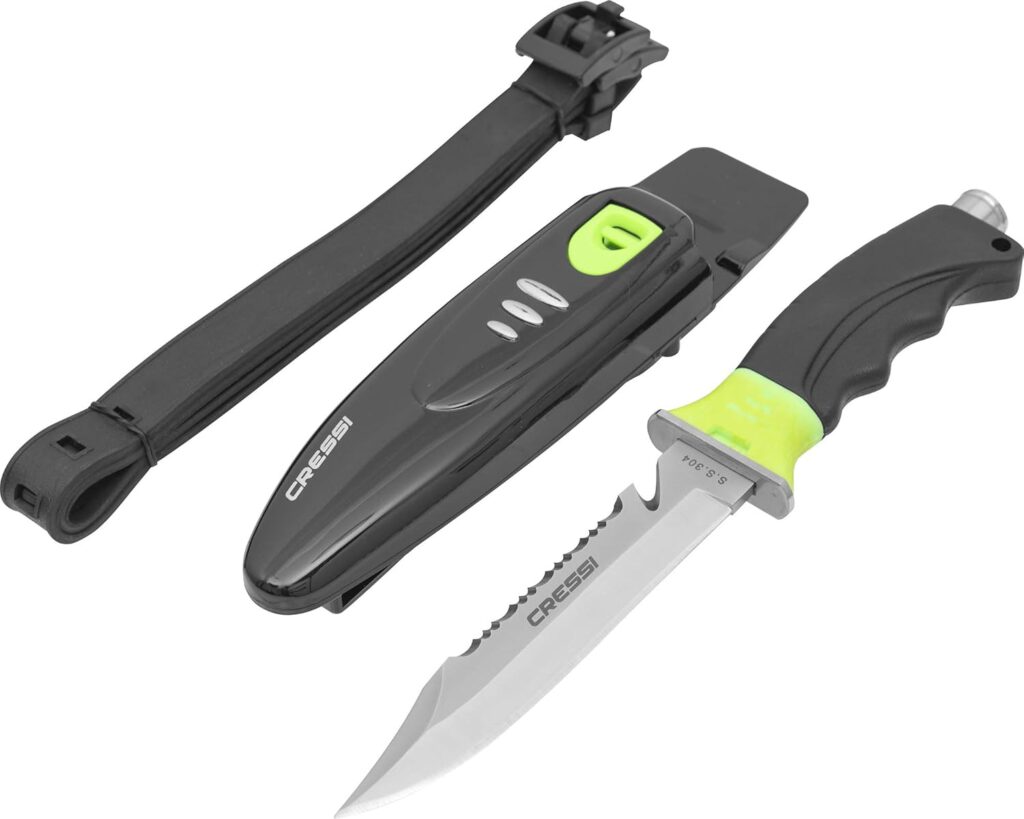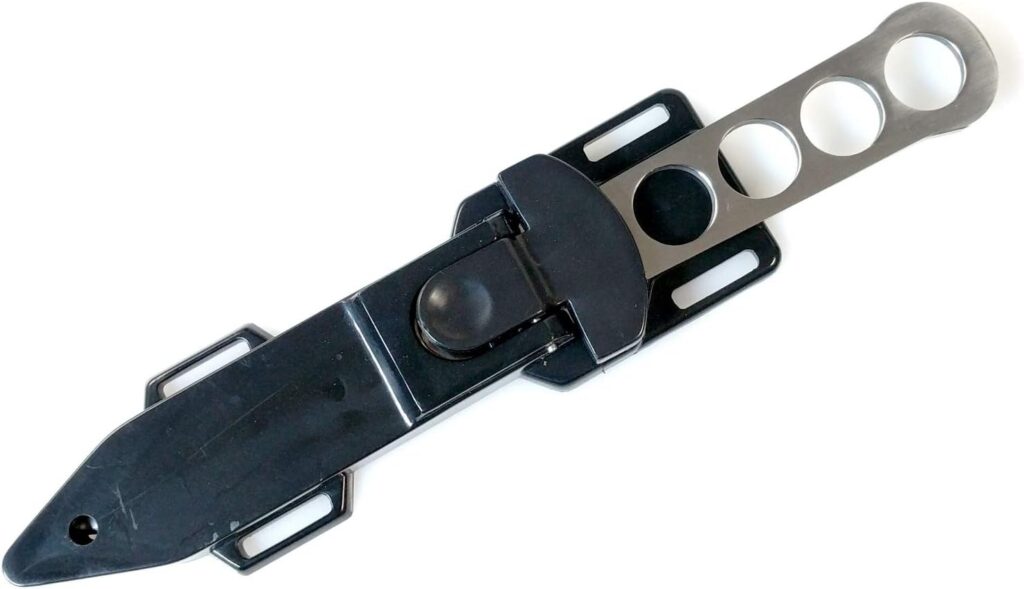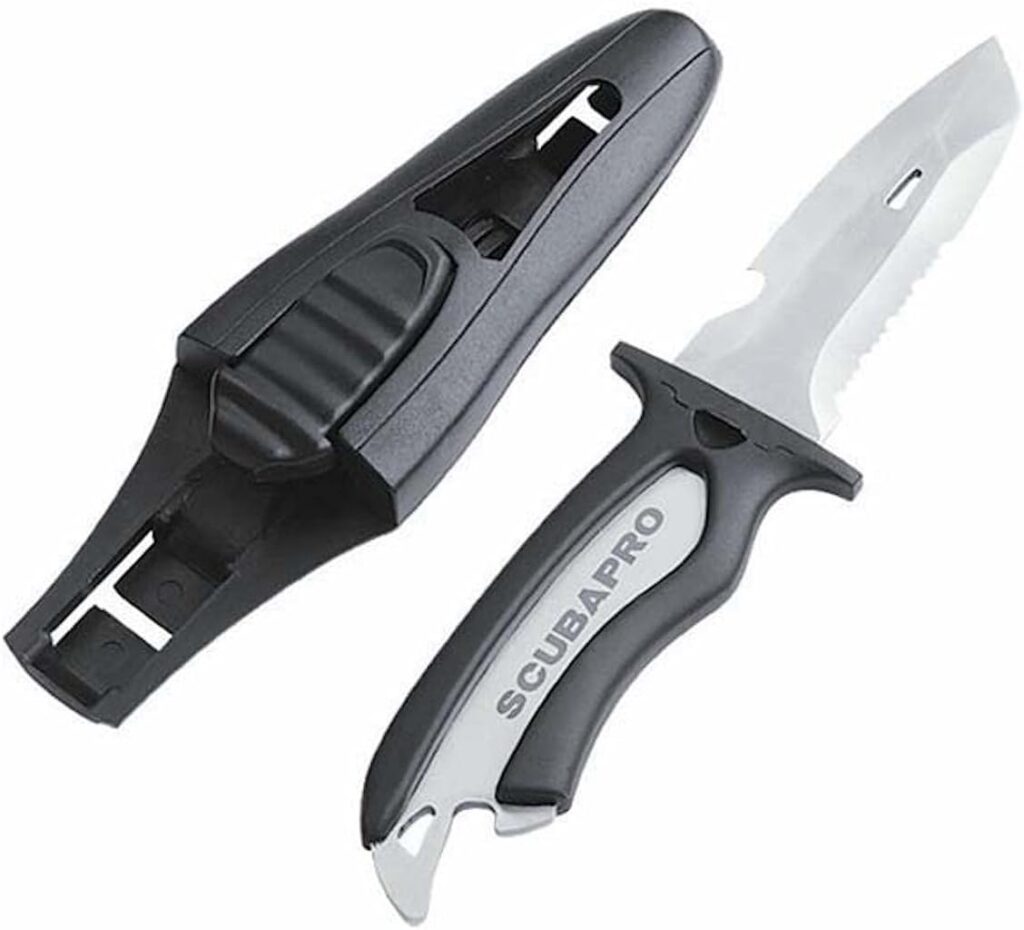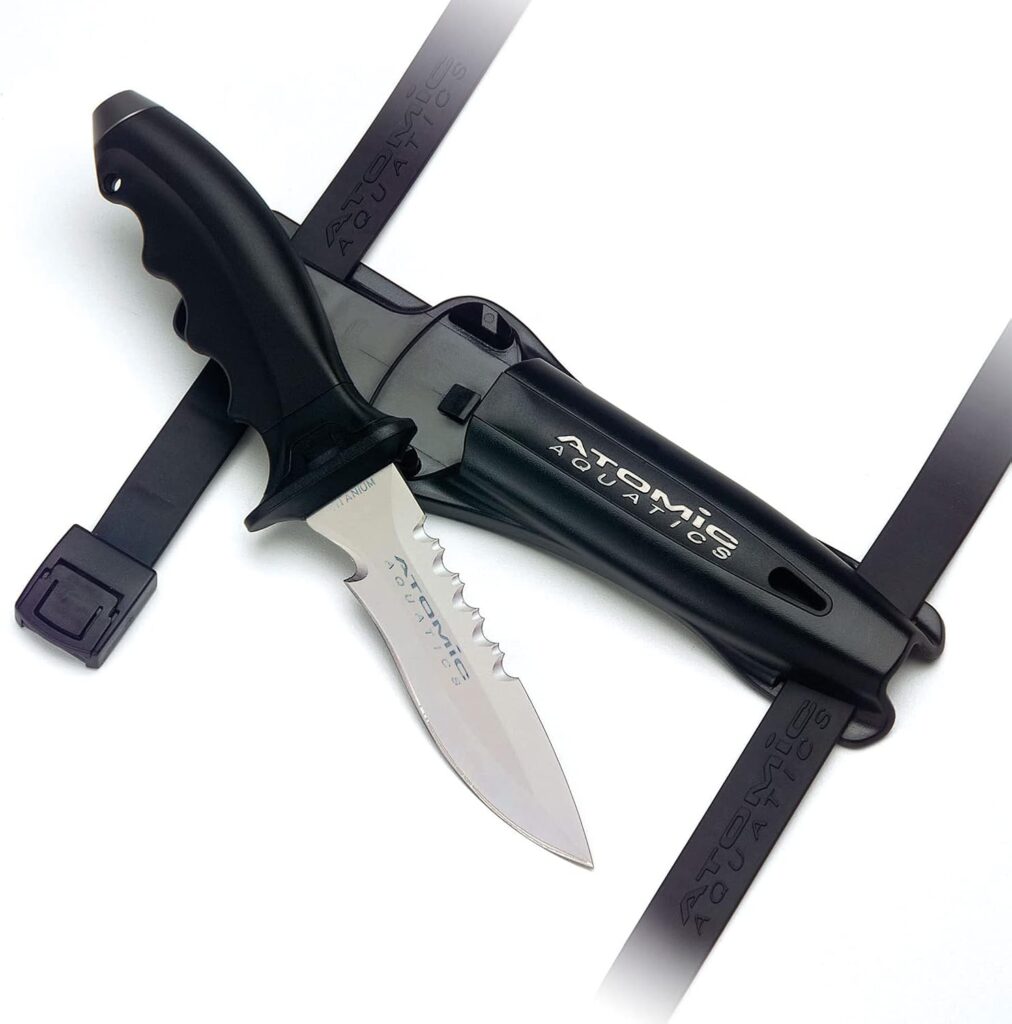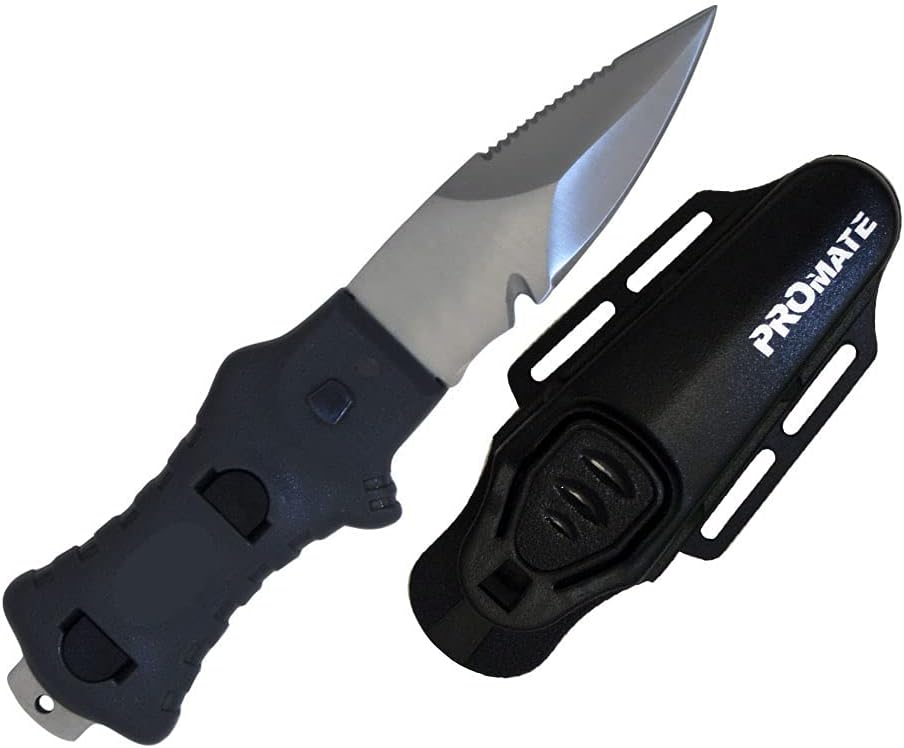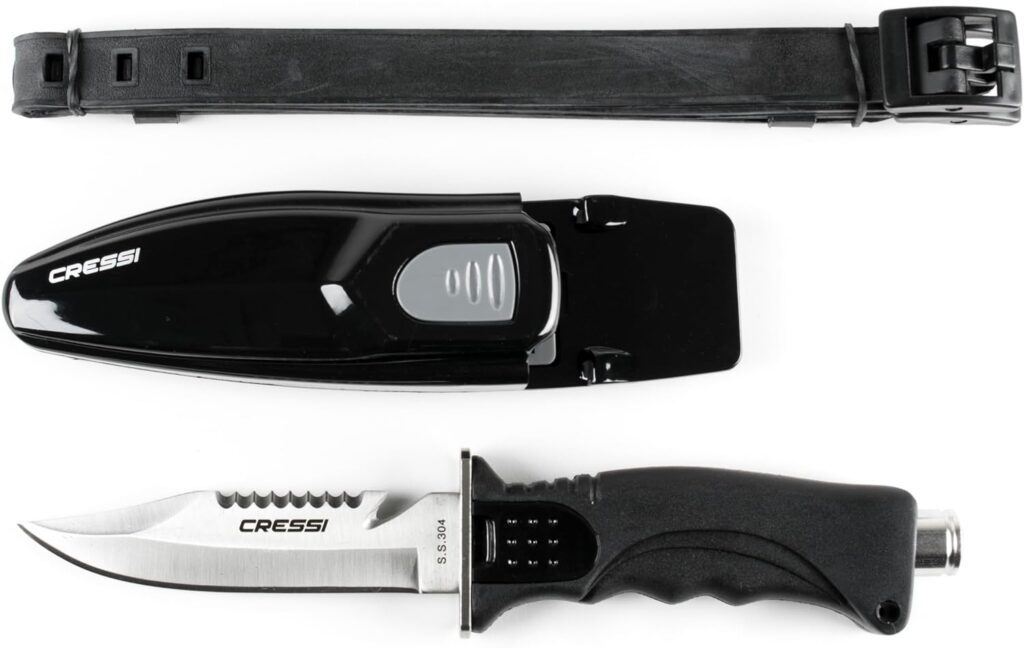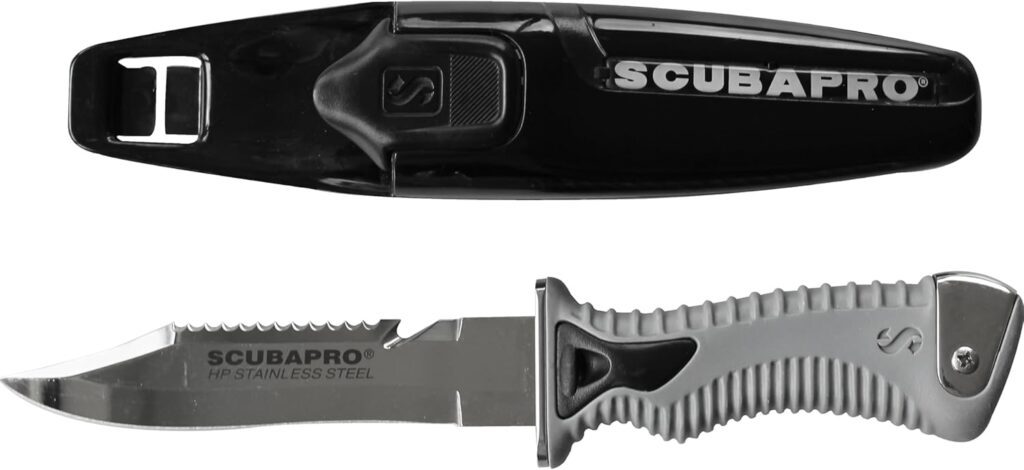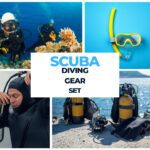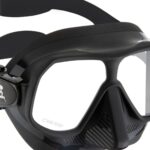10 Best Dive Knives
If you’ve ever dropped into the ocean with all your shiny scuba diving gear set only to realize you forgot your dive knife, you’ll understand why divers joke: “There are two kinds of divers: those who carry the best dive knives, and those who become the story everyone tells on the boat ride back.”
And no, a butter knife from your kitchen drawer doesn’t count.
What Are The Best Dive Knives?
The best dive knives are small, durable blades designed for underwater use, meant to cut through fishing lines, rope, seaweed, or anything that might trap you. The truly best dive knives share a few qualities:
- Corrosion resistance (so saltwater doesn’t turn them into rusty fossils).
- Secure sheaths and easy draw (so you can grab it fast even with thick gloves).
- Cutting power (sharp enough for rope and fishing net, but safe enough not to puncture your wetsuit or inflatable boat).
- Compact design (because you don’t need a sword underwater, just a reliable tool).
If you’re on the hunt for the best dive knives, think of them less as a weapon and more as a seatbelt: something you hope you never need but are grateful for when trouble shows up.
The Best Dive Knives
When divers look for the best dive knives, they want more than just something sharp. A proper dive knife should balance cutting power, corrosion resistance, comfort, and reliability under real underwater conditions.
The following are the best dive knives we reviewed so you can see which tool fits your diving style and needs.
1. Cressi Borg, Long Blade Knife for Diving and Spearfishing
The Cressi Borg offers a longer blade than most, making it a favorite for spearfishers who want reach and cutting strength. Its stainless-steel build provides durability, though it demands care to avoid corrosion. The grip is comfortable, and the included sheath locks firmly in place.
Pros
- Long blade for added leverage
- Comfortable ergonomic handle
- Strong stainless-steel construction
- Secure sheath with quick-release system
- Versatile for both diving and spearfishing
Cons
- Requires thorough rinsing to prevent rust
- Longer length can feel bulky for casual divers
2. TI GEEK Titanium Survival Scuba Diving Fixed Blade Knife
Built with titanium, this knife resists corrosion impressively well and stays light in the hand. The serrated edge and line cutter make it versatile for tackling ropes and fishing lines. Its sheath and multiple mounting options add flexibility for where you carry it.
Pros
- Titanium blade resists rust
- Lightweight for ease underwater
- Includes serrated edge and line cutter
- Multiple secure mounting positions
- Reliable sheath with locking system
Cons
- Harder to sharpen than stainless steel
- Higher price compared to entry-level knives
3. WarTech 8.75″ Diving Survival Knife with Leg Strap Sheath
This knife has a straightforward design with a robust fixed blade suited for basic underwater needs. The leg strap sheath keeps it accessible, though it can shift if not strapped tightly. Affordable pricing makes it appealing for beginners or as a backup.
Pros
- Affordable entry-level option
- Solid fixed blade design
- Comes with a leg strap sheath
- Good length for general use
- Simple and easy to handle
Cons
- Stainless steel prone to rust if neglected
- Sheath not as secure as higher-end models
4. SCUBAPRO Mako Stainless-Steel Diving Knife with 3.5-Inch Blade
Compact and practical, this knife is built for divers who prefer a smaller blade without losing cutting efficiency. The stainless-steel blade has both a straight edge and serrations for versatility. Its compact size makes it easy to mount on BCDs or hoses.
Pros
- Compact and easy to mount
- Combination edge for multiple cutting needs
- Lightweight and travel-friendly
- Sturdy stainless-steel construction
- Secure sheath with quick-release
Cons
- Requires maintenance to prevent rust
- Smaller size limits leverage on thick rope
5. Atomic Aquatics Ti6 Titanium Durable Dive Knife
Titanium build ensures this knife is nearly immune to corrosion while staying lightweight. The ergonomic handle and quick-adjust straps make it easy to use even with gloves. Its lockable sheath system provides excellent retention and quick access.
Pros
- Titanium resists corrosion exceptionally well
- Lightweight and durable
- Ergonomic handle for better grip
- Lockable sheath for secure carry
- Quick-adjust straps for custom fit
Cons
- More expensive than stainless options
- Edge requires more effort to sharpen
6. Promate Point Tip Scuba Dive BC Knife
Promate’s point-tip knife is compact, versatile, and designed for mounting on a BCD. The handle provides solid grip, and the sheath system is straightforward to use. With both serrated and straight edges, it performs well for common underwater cutting tasks.
Pros
- Compact and lightweight design
- Easy to mount on BCD
- Dual edge (straight and serrated)
- Comfortable handle grip
- Affordable pricing
Cons
- Stainless blade prone to rust if not maintained
- Point tip increases puncture risk around gear
7. SZCO Supplies 9-Inch Dive Knife
Brightly colored for visibility, this knife features a stainless-steel blade with a sawtooth spine for heavy-duty cutting. The rubberized grip feels secure, even when wet. Its included leg sheath offers traditional mounting for quick access.
Pros
- Bright handle for visibility underwater
- Strong stainless blade with sawtooth spine
- Rubberized grip enhances handling
- Includes hard sheath with leg strap
- Suitable for both diving and snorkeling
Cons
- Requires regular care to avoid corrosion
- Bulky compared to compact dive knives
8. TUSA FK-940 X-Ppert II Titanium Dive Knife
Engineered with titanium, this knife is both durable and corrosion-resistant. Its curved ergonomic handle and sharp blade design make it excellent for precise underwater cutting. Quick-release sheath mechanism adds ease of use.
Pros
- Titanium blade resists rust
- Curved handle for ergonomic grip
- Sharp and versatile blade edges
- Secure sheath with quick release
- Lightweight construction
Cons
- Premium price range
- Sharpening titanium can be more challenging
9. Cressi Skorpion Tempered Stainless Steel Blade Knife
Compact yet strong, the Skorpion is offered in both blunt and pointed tip versions. The tempered stainless-steel blade provides sharpness with good edge retention. Its sheath is streamlined, making it easy to mount in different positions.
Pros
- Available in blunt or pointed tip versions
- Tempered stainless-steel blade is strong
- Good edge retention with proper care
- Versatile mounting system
- Compact and easy to carry
Cons
- Prone to corrosion without maintenance
- Smaller handle may be less comfortable with thick gloves
10. SCUBAPRO K-6 Stainless Steel Diving Knife
This is a larger, traditional dive knife with a strong stainless-steel blade designed for serious cutting power. Its full-size handle provides solid control, even in gloves. The rugged build makes it suitable for wreck and technical diving.
Pros
- Large blade for heavy-duty cutting
- Strong stainless-steel construction
- Comfortable full-size handle
- Durable sheath included
- Good for wreck or technical dives
Cons
- Bulky compared to compact knives
- Requires frequent maintenance to prevent rust
Why Carry a Dive Knife at All?
Ask any diver who’s gotten snagged in fishing line why a knife matters. Entanglement is one of the most common underwater emergencies. A scuba diving knife isn’t about looking tough, it’s about staying safe. You’re not fighting sharks; you’re freeing yourself from hazards like nylon netting, cable ties, or kelp stalks.
Organizations like Divers Alert Network (DAN) emphasize that divers need a reliable cutting device on every dive. It can be a small knife, a line cutter, or even trauma shears, but the point is the same: be prepared.
Blade Materials: Which Metal Survives the Ocean?
Saltwater is ruthless. The wrong metal can rust overnight. Let’s look at the main contenders:
- Stainless steel: Affordable, sharpens easily, but needs constant care. Rinse and dry after every dive. Think of it like owning a classic car; it works great if you baby it.
- Titanium dive knife: Nearly immune to rust, super light, but harder to sharpen. Perfect for divers who don’t want to fuss over maintenance.
- H1 or LC200N steel: Advanced stainless steels that resist rust better than most. Popular among high-end knives.
- Ceramic blades: Extremely rustproof, but brittle if used for prying.
For casual reef diving, stainless steel works fine if you’re diligent. If you’re forgetful or dive in salt-heavy waters, a titanium knife diving option saves you headaches.
Blade Edge and Cutting Style
Not all edges cut the same things well.
- Straight edge: Great for clean slicing, easy to sharpen.
- Serrated edge: Excellent for rope and webbing; cuts aggressively.
- Combination edge: A bit of both, often the most versatile.
- Hooked line cutter: Small but efficient at slicing fishing line instantly.
Many experienced divers carry two tools: a compact line cutter for fast, precise work, and a knife for heavier tasks.
Tip Shapes: Pointed or Blunt?
Imagine trying to inflate your boat only to realize your knife punctured it. That’s why blunt tips exist.
- Blunt tip: Safer around gear, doubles as a pry tool.
- Pointed tip: Useful for spearfishing or probing but riskier around delicate equipment.
- Sheepsfoot tip: Rounded safety option, excellent for cutting without piercing.
For general diving, a blunt-tip blade is often recommended. But if you’re spearfishing, the best spearfishing knife usually has a pointed edge for dispatching fish quickly.
Fixed Blade vs Folding Knife
- Fixed blade: Always ready, no moving parts, reliable. The classic military dive knife style.
- Folding knife: Compact, discreet, but harder to open with gloves.
Most divers lean toward fixed blades for their reliability, though some like folding knives as backups.
Sheaths and Mounting: Where Do You Carry It?
Where you mount your knife matters. Common options:
- BC (buoyancy compensator): Easy to access, close to the chest.
- Inflator hose mount: Popular for small cutters.
- Calf mount: Classic style, but riskier for entanglement.
- Waistband: Low snag, quick reach.
- Forearm: Old-school look, less common today.
A good sheath locks the knife securely but allows quick release. Practice drawing it with your gloves on before every dive.
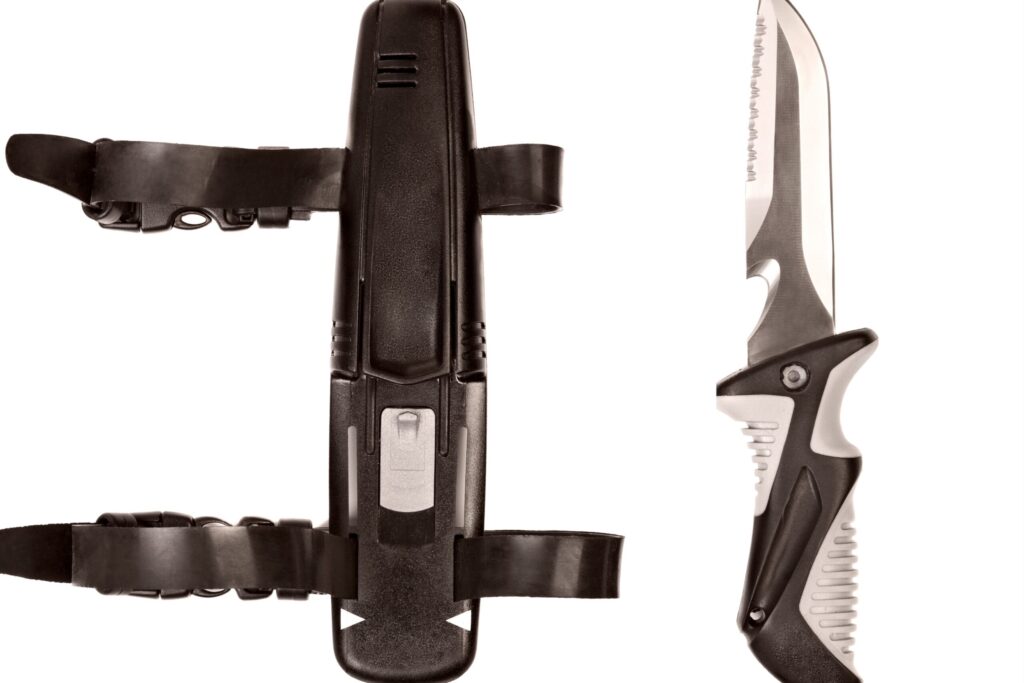
Maintenance: Keeping Rust Away
Even the best dive knife will rust if neglected. After every dive:
- Rinse thoroughly in fresh water.
- Dry completely before storage.
- Apply silicone grease or light oil.
- Store outside the sheath (to prevent moisture trapping).
Sharpen periodically, especially serrated edges which dull slower but require special sharpening tools.
Choosing the Right Knife for Your Dive Style
Different types of diving call for different tools:
- Reef and recreational diving: Small, blunt-tip knives or line cutters.
- Wreck or technical diving: Stronger blades, secure sheaths, backup cutters.
- Spearfishing: Pointed, sharp knife for dispatching fish.
- Cold water diving: Larger handles for thick gloves, corrosion-resistant steel.
If you’re working with a diving weight belt and thicker gear, make sure your knife handle is grippy and large enough to hold with gloves.
Myths About Dive Knives
- “Stainless steel never rusts.” Wrong. It stains less, but saltwater eats it alive if ignored.
- “Bigger is better.” A giant blade is more of a liability underwater, especially with weight belt already heavy. Compact tools work better.
- “Titanium knives never need sharpening.” They resist rust, but edges still dull.
Testing a Dive Knife Before Trusting It
If you really want confidence, test your knife on land:
- Cut through fishing line, braided cord, and small rope.
- Try drawing it with gloves on.
- Shake the sheath upside down to check retention.
- Leave it in saltwater overnight to see how it resists corrosion.
This kind of real-world check separates marketing hype from reality.
Travel Rules for Dive Knives
One of the most asked questions: Can I fly with a dive knife?
Yes, but only in checked luggage. Airlines and airport security will confiscate any knife in carry-on. Some dive operators also have local rules, so check before you pack.
Alternatives and Redundancy
Many divers carry more than one cutting device. A common setup:
- A compact line cutter on the inflator hose.
- A small titanium dive knife on the waist strap.
- Trauma shears tucked into a pocket for backup.
That way, if one fails or is out of reach, another is available.
Environmental and Safety Etiquette
Remember: a dive knife isn’t for chipping coral or poking sea creatures. Use it responsibly. If you’re in a scuba certification course, instructors will likely stress that knives are safety tools, not toys.
Always handle them carefully on the boat. Don’t hand someone a knife blade-first. And never leave it wet in your dive bag.
FAQs on the Best Dive Knives
1. Do I really need a knife for every dive?
Yes. You may never use it, but if you need it once, you’ll be glad you had it.
2. Is titanium always better?
Not always. Titanium resists rust but is harder to sharpen and often more expensive.
3. What is the best spearfishing knife?
One with a sharp point, corrosion resistance, and a sheath that won’t loosen when you’re wrestling a catch.
4. Can I use a military dive knife for scuba diving?
Yes, but they tend to be larger and heavier than most recreational divers need.
5. How do I care for a serrated edge?
Use a tapered diamond sharpener to get between the teeth. Don’t ignore them, dull serrations cut poorly.
The Bottom Line on The Best Dive Knives
Finding the best dive knives isn’t about owning the flashiest blade. It’s about safety, reliability, and practicality. Choose a knife that resists rust, cuts cleanly, and mounts securely in a spot you can reach with either hand.
A best dive knife is like a good dive buddy: you may not think about it much, but when trouble comes, you’ll be glad it’s there.
